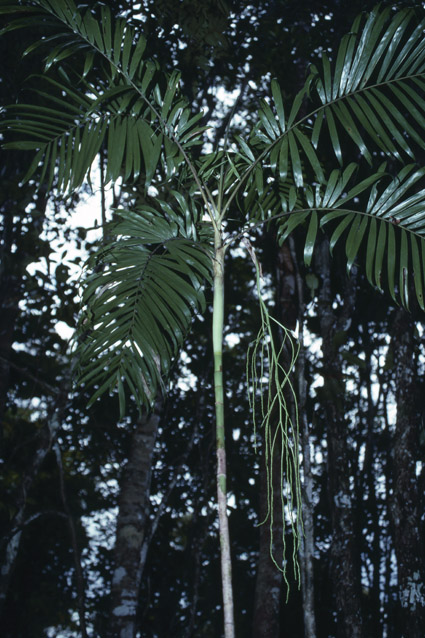- Acanthophoenix
- Acrocomia
- Actinokentia
- Actinorhytis
- Adonidia
- Aiphanes
- Allagoptera
- Ammandra
- Aphandra
- Archontophoenix
- Areca
- Arenga
- Asterogyne
- Astrocaryum
- Attalea
- Bactris
- Balaka
- Barcella
- Basselinia
- Beccariophoenix
- Bismarckia
- Borassodendron
- Borassus
- Brassiophoenix
- Burretiokentia
- Butia
- Calamus
- Calyptrocalyx
- Calyptrogyne
- Calyptronoma
- Carpentaria
- Carpoxylon
- Caryota
- Ceratolobus
- Ceroxylon
- Chamaedorea
- Chamaerops
- Chambeyronia
- Chelyocarpus
- Chuniophoenix
- Clinosperma
- Coccothrinax
- Cocos
- Corypha
- Cryosophila
- Cyphokentia
- Cyphophoenix
- Cyphosperma
- Daemonorops
- Deckenia
- Desmoncus
- Dictyocaryum
- Drymophloeus
- Elaeis
- Eleiodoxa
- Eremospatha
- Eugeissona
- Euterpe
- Gaussia
- Geonoma
- Guihaia
- Hedyscepe
- Hemithrinax
- Howea
- Hyophorbe
- Hyospathe
- Hyphaene
- Iriartea
- Iriartella
- Itaya
- Jailoloa
- Johannesteijsmannia
- Juania
- Jubaea
- Jubaeopsis
- Kentiopsis
- Kerriodoxa
- Korthalsia
- Laccospadix
- Laccosperma
- Lanonia
- Latania
- Lemurophoenix
- Leopoldinia
- Lepidocaryum
- Lepidorrhachis
- Leucothrinax
- Licuala
- Linospadix
- Livistona
- Lodoicea
- Lytocaryum
- Manicaria
- Manjekia
- Marojejya
- Masoala
- Mauritia
- Mauritiella
- Maxburretia
- Medemia
- Metroxylon
- Myrialepis
- Nannorrhops
- Nenga
- Neonicholsonia
- Neoveitchia
- Nephrosperma
- Normanbya
- Nypa
- Oenocarpus
- Oncocalamus
- Oncosperma
- Orania
- Oraniopsis
- Parajubaea
- Pelagodoxa
- Phoenicophorium
- Phoenix
- Pholidocarpus
- Pholidostachys
- Physokentia
- Phytelephas
- Pigafetta
- Pinanga
- Plectocomia
- Plectocomiopsis
- Podococcus
- Pogonotium
- Ponapea
- Prestoea
- Pseudophoenix
- Ptychococcus
- Ptychosperma
- Raphia
- Ravenea
- Reinhardtia
- Retispatha
- Rhapidophyllum
- Rhapis
- Rhopalostylis
- Roscheria
- Roystonea
- Sabal
- Sabinaria
- Salacca
- Saribus
- Satakentia
- Satranala
- Schippia
- Sclerosperma
- Socratea
- Solfia
- Sommieria
- Syagrus
- Synechanthus
- Tahina
- Tectiphiala
- Thrinax
- Trachycarpus
- Trithrinax
- Veitchia
- Verschaffeltia
- Voanioala
- Wallaceodoxa
- Wallichia
- Welfia
- Wendlandiella
- Wettinia
- Wodyetia
- Zombia
- x Jubautia splendens
- ?? Acoelorrhaphe
- ?? Bentinckia
- ?? Brahea
- ?? Clinostigma
- ?? Colpothrinax
- ?? Copernicia
- ?? Cyrtostachys
- ?? Dictyosperma
- ?? Dransfieldia
- ?? Heterospathe
- ?? Hydriastele
- ?? Iguanura
- ?? Incertae sedis & excluded names
- ?? Loxococcus
- ?? Micronoma
- ?? Paripon
- ?? Pritchardia
- ?? Rhopaloblaste
- ?? Serenoa
- ?? Washingtonia

Introduction
- A strikingly beautiful small palm of the forest undergrowth, known as yet from a single collection from the lowlands in the southeast of the island. The species name refers to the interrupted sequence of otherwise regularly arranged leaflets on each side of the rachis. (Dransfield, J. & Beentje, H. 1995: The Palms of Madagascar)A
Distribution
Ifanadiana area. (Dransfield, J. & Beentje, H. 1995: The Palms of Madagascar)A
Discussion
- .This taxon, although known only from a single specimen, is so distinctive that we have considered it important to name it, even though several
parts are not represented. Among the species of Dypsis with three sagittate antesepalous stamens and a conical pistillode, D. interrupta is immediately distinguishable by its numerous linear leaflets arranged in an interrupted series on each side of the rachis. This is clearly a very beautiful species and it would be desirable not only to recollect it to complete our understanding of it as a species, but also to introduce it into cultivation. It was found growing on a steep slope in open forest. (Dransfield, J. & Beentje, H. 1995: The Palms of Madagascar)A
Diagnosis
- Inter species floribus staminatis triandris staminibus antesepalis pistillodio conico foliolis linearibus numerosis in quoque latere rachidis interrupte dispositis distinctissima. (Dransfield, J. & Beentje, H. 1995: The Palms of Madagascar)A
Biology And Ecology
- Hill forest; 510 m. (Dransfield, J. & Beentje, H. 1995: The Palms of Madagascar)A
Conservation
- Critical. The extraordinary forests of Ambinanindrano are gradually being destroyed by shifting cultivation. (Dransfield, J. & Beentje, H. 1995: The Palms of Madagascar)A
Common Name
- Not recorded. (Dransfield, J. & Beentje, H. 1995: The Palms of Madagascar)A
Uses
- Not recorded. (Dransfield, J. & Beentje, H. 1995: The Palms of Madagascar)A
Description
- Solitary palm of forest undergrowth. STEMS to 3 m tall, c. 12 mm diam.; internodes 60-70 cm long. LEAVES 7 in crown; sheaths forming a well defined crownshaft; sheath 19-20 cm long, 1.5 cm diam., with sparse scattered dark brown scales; low auricles present but apparently soon tattering; petiole 9-12 cm long, c. 4 x 2 mm in cross section, deeply channelled, rather densely covered in discrete dark brown scales; rachis 64-70 cm long, scaly as the petiole; leaflets 24-29 on each side of the rachis, all except the apical pair single-fold, linear, grouped in proximal part of the leaf, regularly arranged distally, regularly arranged within the groups, the leaflet series thus appearing interrupted rather than fascicled, mid-leaf leaflets 15-23 x 0.8-1.5 cm, apical pair slightly shorter, basalmost leaflets 6-8 x 0.4-0.8 cm, leaflet midrib prominent adaxially, texture membranous. INFLORESCENCE interfoliar, branched to 2 orders, arching with pendulous rachillae; peduncle 50 cm long, c. 4 mm wide at the base, tapering to 2.5 mm wide, glabrous; prophyll inserted 14.5 cm above the base of the peduncles, 30 x 1.5 cm, membranous, striate, very sparsely scaly; peduncular bract inserted c. 20 cm above the prophyll, otherwise not known; rachis c. 30 cm long, glabrous; rachillae slender, c. 20, 19-30 cm long, glabrous, c. 1.5 mm diam., triads c. 3 mm apart, rachilla bract c. 0.8 mm high, rounded, glabrous. FLOWERS very immature in available specimen. STAMINATE FLOWERS with 3 ?sagittate antesepalous stamens and a conical pistillode. FRUIT unknown. (Dransfield, J. & Beentje, H. 1995: The Palms of Madagascar)A
Materials Examined
- Ifanadiana: 1 km S of Ambinanindrano, 17-19 Nov. 1991 (fl. buds), Beentje 4528 (holotype K; isotype TAN). (Dransfield, J. & Beentje, H. 1995: The Palms of Madagascar)A
- Log in to post comments

